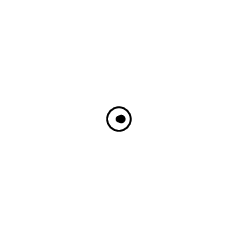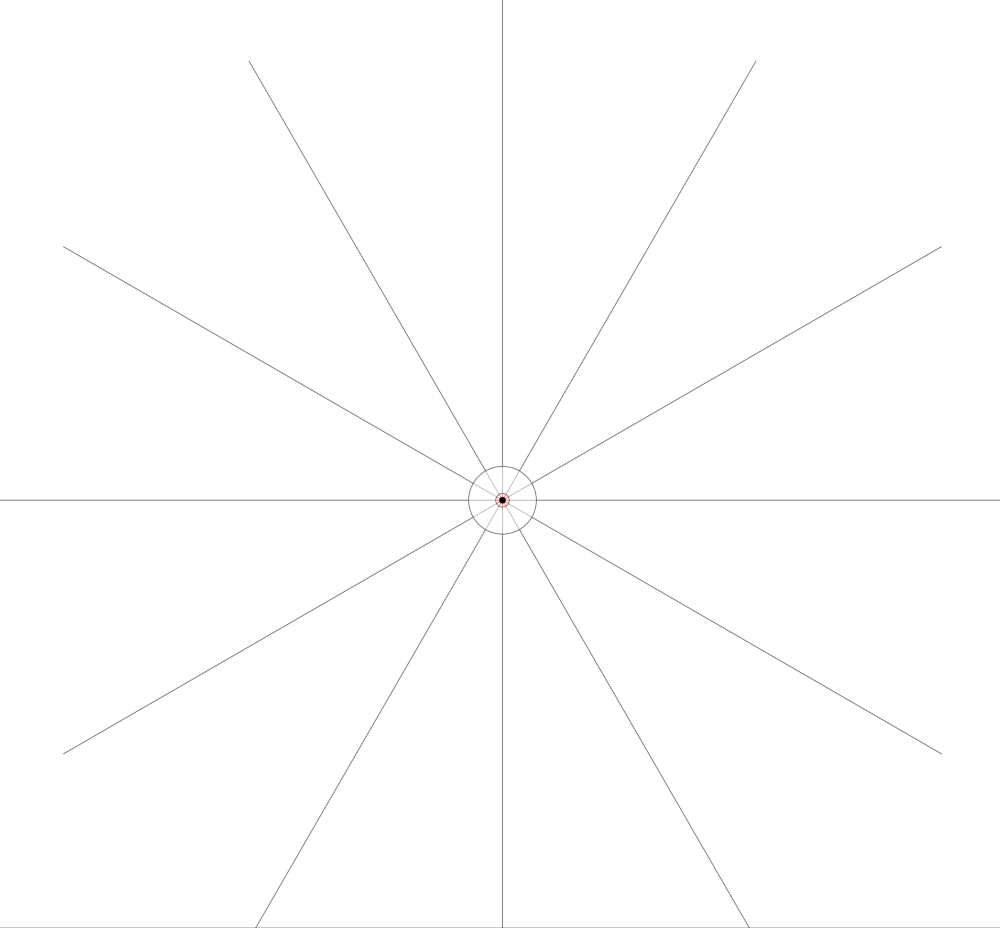
我绞尽脑汁了数周,试图创建一个 .gif,它是下图所示的移动版本。

目标是从同一位置(原点)的点 (A) 和 (B) 开始,黑线从该点开始发散。
然后,将 (B) 向右移动到任意点。当 (B) 向右移动时,它会产生一个向外辐射的脉冲(环)。
随着环向外辐射,它会露出红线,随着环的移动,红线会从 (B) 处发散。
我目前的进展是:
\documentclass[tikz]{standalone}
\usepackage{tikz}
\usetikzlibrary{calc}
\begin{document}
\foreach\radius in{1,...,10}{
\begin{tikzpicture}
\def\innerring{\radius/10-.08}
\def\dottoinner{\radius/10+.08}
\def\outerring{\radius/10}
\draw [color=white] (-1,0) -- (1,0); %Used to keep frame the same size
\draw [color=white] (0,-1) -- (0,1); %Used to keep frame the same size
%When the dot is moving
\ifnum\numexpr\radius<4
%\draw [color=red] (\innerring, 0) -- (-\innerring,.2); %tried, failed, try again
\draw [color=red] (\innerring, 0) -- (-\dottoinner,0);
\node (A) at (\innerring, 0) [circle,fill,inner sep=.7pt]{};
%Whent the dot is no longer moving
\else
%\draw [color=red] (.4-.08, 0) -- (-\innerring*.707,\innerring*.5); %tried, failed, try again
\draw [color=red] (.4-.08, 0) -- (-\dottoinner,0);
\node (B) at (.3, 0) [circle,fill,inner sep=.7pt]{};
\fi
%The pulse of radiation
\draw [thin] (0,0) circle[radius=\outerring] node (C) {};
\draw [thin] (0,0) circle[radius=\innerring] node (D) {};
\end{tikzpicture}
}
\end{document}
生成 gif 图像:
问题的关键在于我似乎无法想出一个表达式来将从点 (B) 到内圆的非水平线联系起来,而不会让它们随着圆圈的扩大而改变角度。
我可以为此项目提供所有的软件包。
答案1
这是一个非常简单的计算。x圆心的坐标B由下式给出:
B_x = r * a ,
其中r是圆的半径,是速度。从角度 alpha 下0<a<1发射的射线具有参数化B
gamma(t) = (B_x + t*cos(alpha), t*sin(alpha)) .
A它们与半径为的圆的交点r可以通过要求获得
|gamma(t_crit)|^2 = r^2 .
这是一个二次方程,它有一个唯一的正解,一个简单的函数tcrit,我在下面的代码中输入了它。
\documentclass[tikz,border=3.14mm]{standalone}
\begin{document}
\foreach \R in {0.2,0.3,...,4.5}
{\begin{tikzpicture}[declare function={a=0.6; % velocity
tcrit(\r,\ang)=(-2*a*\r*cos(\ang)+sqrt(2)*sqrt(\r*\r*(2-a*a+a*a*cos(2*\ang))))/2;}]
\clip (-5,-5) rectangle (5,5);
\foreach \ang in {0,22.5,...,337.5}
{\draw[very thick] (a*\R,0) -- ++(\ang:{tcrit(\R,\ang)}) --
(\ang:1.2*\R) -- (\ang:10);}
\draw[thick,even odd rule,fill=white,fill opacity=0.5] (0,0) circle[radius=\R]
circle[radius=1.2*\R];
\end{tikzpicture}}
\end{document}
答案2
我对这个答案不是特别满意,因为它需要很长时间来渲染,并且第 1 帧和第 3 帧有点不可靠(仍在尝试解决这个问题)但它在这里:
\documentclass[tikz]{standalone}
\usepackage{tikz}
\usetikzlibrary{calc,intersections}
\begin{document}
\foreach\radius in{1,...,10}{
\begin{tikzpicture}[scale=10]
\def\innerring{\radius/10-.08}
\def\dottoinner{\radius/10+.08}
\def\outerring{\radius/10}
\def\dot{\radius/10-0.1}
\node at (-1,-1) {};
\node at (1,1) {};
\foreach \x in {0,30,...,330} {
\draw (\x:\outerring) -- (\x:1.5);
}
\draw [thin] (0,0) circle[radius=\outerring];
\draw [thin] (0,0) circle[radius=\innerring];
%When the dot is moving
\ifnum\numexpr\radius<4
% \draw [color=red] (\innerring, 0) -- (-\innerring,.2); %tried, failed, try again
% \draw [color=red] (\innerring, 0) -- (-\dottoinner,0);
\node (A) at (\dot, 0) [circle,fill,inner sep=2pt]{};
\foreach \x in {0,30,...,330} {
\begin{scope}
\clip (0,0) circle[radius=\innerring];
\draw[name path=P1,red] (A) -- +(\x:5);
\end{scope}
\draw[name path=P2,draw opacity=0] (0,0) circle (\innerring);
\path [name intersections={of=P1 and P2,by=E}];
\draw[black!50] (E) -- (\x:\outerring);
}
%Whent the dot is no longer moving
\else
%\draw [color=red] (.4-.08, 0) -- (-\innerring*.707,\innerring*.5); %tried, failed, try again
% \draw [color=red] (.4-.08, 0) -- (-\dottoinner,0);
\node at (A) [circle,fill,inner sep=2pt]{};
\foreach \x in {0,30,...,330} {
\begin{scope}
\clip (0,0) circle[radius=\innerring];
\draw[name path=P1,red] (A) -- +(\x:5);
\end{scope}
\draw[name path=P2,draw opacity=0] (0,0) circle (\innerring);
\path [name intersections={of=P1 and P2,by=E}];
\draw[black!50] (E) -- (\x:\outerring);
}
\fi
\end{tikzpicture}
}
\end{document}
我根据你一开始的图像制作了它





